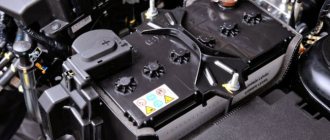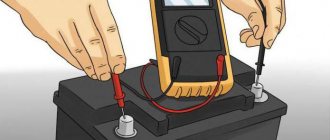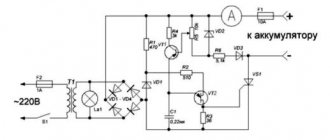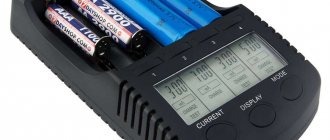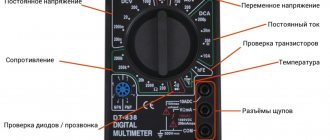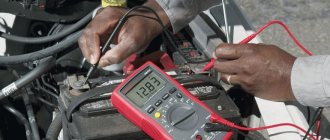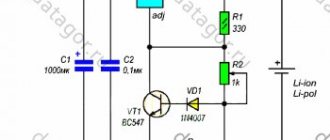Nobody argues, the Chinese produce products in enormous volumes that are accessible to the masses. But, how tired we are all of the fake technical characteristics of Chinese equipment belonging to any price category! Yes, the truth is often unpleasant, but still, sometimes you just need to know it. In this topic, I want to talk about the capacity of batteries, and specifically, about the discrepancy between the indicators declared by the manufacturer (overestimated) and the real ones. We will talk about lithium-ion batteries of the 18650 format - we will determine their real capacity using a multimeter.
What do the numbers 18650 mean?
What do the numbers 18650 mean on a lithium-ion battery? The first two digits are the diameter of the battery, 18 mm, followed by the number 65 - the length of the battery, also measured in mm, and the remaining zero indicates a cylindrical shape. The 18650 format is the most common among lithium-ion electronic storage devices, and in terms of dimensions, it is slightly larger than a traditional AA battery. Everything that concerns 18650 format batteries also applies to Li-ion batteries of other formats.
Batteries of this type often power small flashlights, lasers and a wide variety of other electronics. Batteries for laptops, screwdrivers, and electric cars are assembled from 18650 format elements. Many users admire how powerful and useful these batteries are! But not every user knows how to correctly determine the capacity of an 18650 component, so on the Internet you can find a large number of recommendations.
Checking the capacity of Li-ion battery 18650
There are different electronic storage devices on the market, so the approach to measuring their parameters is individual.
The capacity of a rechargeable battery is considered one of its most important indicators. Manufacturers of such devices indicate capacity numbers on the body of the electronic drive, but in the vast majority of cases this characteristic is overestimated.
To verify the veracity of the data, special measuring instruments have been developed, and homemade equipment is also available.
So, what exactly can be said about checking the capacity of 18650 lithium-ion batteries:
1. You can determine the approximate actual battery capacity by charging the gadget with a known current. Often the charging current is indicated in the technical specifications of the charger. If it takes 34 hours to fully charge an electric storage device with a current of 100 milliamps, then by multiplying these values, you can find out that the capacity of such an electric battery is 3400 mAh. However, you should not completely trust the results obtained, because everything depends on the algorithm of the charger’s functioning.
2. The following method involves a more accurate and faster measurement system, but it requires financial investment! We purchase an intelligent charger (for example, iMax B6), which displays the real voltage and capacity of the electric battery. Also, if you purchase such a device, it will be easier for you to maintain electrical elements!
3. The third method for determining capacity is the most intriguing. The more modest the charge current, the more accurate the data. For this action you need: a 100% charged battery, a watch, an ammeter, and a flashlight. Perhaps the 18650 lithium-ion batteries were purchased specifically for the flashlight? But that’s not the point! You can do without an ammeter, but this is only permissible if you have technical specifications at your disposal that show how much electricity the lighting device will consume at a specific brightness mode.
Turn on the flashlight and set the minimum brightness, measure the current with an ammeter and note the time during this maneuver. For example, the device shined for 20 hours, while consuming a current of 100 mA, and from this it follows: 20 × 100 = 2000 mAh. The capacity of this particular drive could be more impressive, but 2000 mAh is not an impressive figure!
Naturally, the more time-tested a manufacturer is, the more truthful its performance is! What brands can be safely included in this list? We won’t guess on the tea leaves - all the names are known in the global community of lovers of advanced technologies! Japanese Panasonic, South Korean Samsung and LG - these developers provide users with the most accurate information. However, there is no perfection in the world - there may be a discrepancy with real indicators, plus or minus 50 mAh. But that’s not all, the difference can be even more significant, in a negative direction, of course, if the battery is used or, even worse, defective. It’s not difficult to run into such surprises; sellers, in pursuit of profit, put very attractive price tags on such products, but is it worth it?
Next, I will focus my attention on the second method of determining the actual capacity of a battery.
So, checking the 18650 lithium-ion battery using iMax B6 smart charging
The first thing we need to do is naturally acquire this very useful device, the main advantages of which are versatility and relatively accurate measurements of battery capacity. Checking 18650 batteries is not a quick process: first, the cells need to be charged 100%, and then completely discharged, measuring the ampere-hours given. Next, the electric battery is set to storage mode.
The next step is to assemble a balancing charger based on the iMax B6, which allows you to charge up to six batteries simultaneously. The capacity of electronic storage devices will have to be diagnosed individually, and the reason is simple - when checking several components at the same time, you will only get average data. But at the same time, these indicators are enough to find out whether everything is in order with the batteries.
Nuance
Measurements of the values of various parameters using a multifunctional measuring device are carried out starting from the highest range. Such actions are designed to prevent the components of the gadget from burning out, and they also protect the user from electric shock. In any case, never forget about safety precautions when using electrical equipment! As they say, God protects those who are careful!
Types of batteries
Portable batteries differ both in operating principle and in appearance. Main types of batteries:
- Finger (size designation AA);
- Pinky (size AAA);
- Large cylindrical (size D);
- Medium cylindrical (designated C);
- Krone type (shape - parallelepiped);
- Flat (shape - flattened parallelepiped).
All cylindrical types of charge storage devices have an operating voltage of 1.2 to 1.6 volts. The voltage of Kron type elements is 9 V, and flat 4.5 V. The performance of the element depends on the load to which it is connected.
In low-power devices, a decrease in battery voltage does not affect performance for a long time, but in powerful devices, such as cameras or electric motors, even a slight drop in voltage will cause equipment failure.
Batteries also differ in the type of internal filling. The following types are distinguished:
- “Salt”, “dry” - carbon-zinc. This type of battery is the cheapest, but it discharges the fastest and does not work well in cold conditions and with powerful loads;
- HeavyDuty - zinc chloride, similar to the previous type, have a slightly larger capacity;
- “Alkaline”, alkaline - work better at low temperatures and hold a charge at high current, but discharge quickly;
- With the use of mercury - high-capacity, they are difficult to quickly discharge, however, due to the danger of mercury, they have fallen out of use;
- Using silver - they discharge slowly and work well with a powerful load, but are expensive;
- Lithium - have the highest capacity and the smallest weight among similar ones. Long shelf life. High price.
Also, all batteries are divided into two types: primary, that is, galvanic cells and secondary, that is, rechargeable or rechargeable. The former are usually cheaper, but must be disposed of after use. The latter often have a lower capacity, are more expensive, but can be recharged with a charger.
How to measure the voltage of a 18650 battery with a multimeter?
Electric batteries are used by many electronic equipment enthusiasts, but few of them know how important the voltage that the battery produces is for the equipment they use. After all, if you mess something up, failure can’t be avoided!
Below I will give an algorithm for checking the battery voltage using a multimeter:
1. The measuring device is switched to voltage mode up to 20V.
2. Next, the tips of the probes are attached to the power terminals - plus and minus.
3. After a few seconds, the voltage will be displayed on the multimeter screen. If such an action does not take place, we perform the first and second maneuvers again.
Nuance
If you see a “-” sign on the display near the numbers, this will mean that when connecting clamping elements or probes, a “polarity reversal” occurs. Does such a phenomenon pose a threat? No - it's not critical! However, for the normal functioning of the measuring device, it is better not to make such mistakes. The rule here is simple: there is no need to rush when measuring voltage.
The following shows the dependence of the battery charge level on voltage:
Screwdriver battery design and types of “cans”
Regardless of the model of the tool, all batteries in them have the same design. Inside there are elements connected in series - batteries with “banks”. The final battery voltage is created by summing the voltage from all these components.
The battery design has four contacts that are easy to see on the device:
- Two power ones, used when discharging and charging the battery.
- One control, which is connected to the installed thermal sensor. Used to protect charging from overheating.
- The fourth contact is service. Needed to check the charges in installed batteries.
How to measure the capacity of a 18650 battery using a multimeter?
So, let's measure:
1. We charge the battery 100% and connect the load to it.
2. Let's note the time.
3. In parallel, you need to connect a multimeter to the poles, switching the device to the measuring range up to 20 W. This action is performed to track the level of decay of the potential difference.
4. The actual value of the capacity is found by resorting to the following calculation: the current consumed by the load is multiplied by the duration of its operation provided by a fully charged battery. The data obtained is measured in Ampere-hours (Ah).
By the way, today on the market you can find a large number of universal 18650 battery chargers equipped with a capacity detection function. Depending on the manufacturer, they can determine the capacity with varying degrees of error, but in any case, the error will not be large.
Model chargers are one of the first convenient microprocessor chargers that make it possible to test almost all types of batteries for the accuracy of capacity indicators. In this case, the following requirement must be met: there must be a minimum number of connections in the element connection chain, since for this reason losses will be reduced and the accuracy of the results obtained during testing will be increased.
In addition to the model gadgets, it is necessary to connect the balancing cables to the power cables, this is done so that the results are taken specifically through the balancing elements and a four-point testing technique is used. In addition, the equipment manufacturer also plays a significant role in this process. For example, Ai Charger is extremely popular among users because products from this brand offer high measurement accuracy and improved stability.
Nuances
- Carry out all measuring manipulations with Li-ion batteries wearing safety glasses.
- Do not try to short-circuit the “minus” and “plus” cells directly, without loads.
- Do not charge lithium-ion batteries above or below the values given in the official instructions for them.
Control measurement
We put the discharged 18650 battery on charge and wait. If during the charging process the voltage cannot cross the 4 Volt mark, then we send it straight to the trash, and it won’t even be possible to restore it. Otherwise, this still doesn’t mean anything and we continue to freeze...
By capacity
As we move beyond the 4V mark, we look at the capacity. If it is less than 200 mAh, then it can also be safely disposed of. For any working battery, the capacity should already go beyond 800 mAh to 4 volts.
If you really don’t want to rush, then you can do a full discharge and put it on charge again. If the capacity becomes larger the second time when crossing the four-volt boundary, then you can repeat it many times and try to “swing” the jar.
Upon voltage sag
So, our test subject is charged to 4.2V, what next? You can measure the internal resistance with the same devices that I mentioned above. If the internal resistance is significantly higher than that of similar workers, then it’s also in the landfill.
There is nothing to measure internal resistance with? So we apply Ohm's Law for the complete circuit. We connect a small load. If the voltage immediately drops below the standard operating 3.6 V, it also means “HANA”.
With iMax
We wrote about the iMax and all the tricks it allows you to do with batteries in this review of the iMax B6. He can measure the capacity in the most correct way - directly by complete discharge and charge. And it can be restored by charging with a low current, plus “swinging”.
Considering the dense presence of different batteries everywhere in our lives, I think it’s worth buying it once.
Expert opinion
Viktor Pavlovich Strebizh, lighting and electrical expert
Any questions ask me, I will help!
When measuring the voltage of an already fully charged screwdriver, the value should be equal to the number of cans multiplied by the voltage of each battery. If there is something you don’t understand, write to me!
How to check the internal resistance of Li-ion 18650 cells?
To bring this process to life, repeat all the steps below:
1. A load is connected to the battery: a light bulb, an electric motor or any other special equipment.
2. The load must be applied for a couple of seconds for full operation.
3. Next, measure the power supply voltage (U1).
4. Then turn off the load completely and hold it for a couple of seconds.
5. After waiting, the voltage at the battery poles (U2) is again measured.
6. Then, they find the difference between a couple of values U1 and U2, then divide by the nominal potential difference specified by the manufacturer, and then the result is converted into percentage data. If the resulting figure is less than 0.4%, this will mean that the internal resistance is within acceptable limits. But if you are faced with a figure of 0.5% or higher, then, alas, such components are no longer suitable for further use and will have to be replaced.
What parameters can you check?
Using this electrical characteristics meter, you can find out the battery capacity, voltage (potential difference) between its poles, internal resistance, and leakage current.
How to measure voltage
Measuring the value of this characteristic on a rechargeable power source using a multimeter is carried out as follows:
- The meter switches to the DC voltage measurement range up to 20 V;
- The tips of the probes are applied to the power supply poles (terminals) of the same name;
- After a few seconds, the current battery voltage value is displayed on the display.
On a note. If the “–” sign is displayed on the display next to the numbers, this means that when connecting the clamps or probe tips, a “polarity reversal” occurred: the probes are applied not to like poles, but to opposite poles (the negative black probe is applied to the positive pole, the red positive one is applied to This situation does not pose any particular danger, but for normal operation of the meter it is better to avoid it and ensure that the polarity of the probe connections is observed.
Measuring potential difference using a multifunction meter
How to measure capacitance
You can find out the battery capacity as follows:
- The battery is fully charged, after which a load with a previously known current consumption, for example, an incandescent lamp, is connected to it;
- The time during which the load will operate normally is noted;
- At the same time, the probes (clamps) of the multimeter are connected to the poles, switching it to the mode for measuring direct voltage in the range of up to 20 V. This operation is necessary in order to monitor the level of drop in the potential difference, turning off the load at the moment when the power supply is minimal acceptable value of this characteristic.
- The actual value of the characteristic is found by making a simple calculation: multiplying the current consumed by the load by the time of its normal operation from a fully charged battery. The result obtained is expressed in Ampere hours (A*hour, Ah).
In addition to a multimeter, the capacity of rechargeable elements is measured using a device such as a tester.
How to check internal resistance
To check the internal resistance of the battery, perform the following manipulations:
- A load is connected to the battery: a light bulb, a motor or some kind of tool;
- Let the load run for 5-10 seconds;
- Measure the supply voltage (U1);
- Disconnect the load;
- Re-measure the voltage at the battery poles (U2);
- Find the difference between the two values U1 and U2, then divide it by the nominal potential difference declared by the power supply manufacturer, then convert the result into a percentage. If, in percentage terms, the value obtained based on calculations is less than 0.4%, then the internal resistance is normal.
Elements with an indicator exceeding this value are considered unsuitable and even dangerous for further use.
How to check leakage current
Leakage current is a dangerous, undesirable phenomenon for any rechargeable power supply. Checking its presence on the car power source is as follows:
- Turn off the ignition;
- All consumers operating with the ignition off are turned off: radio, security system;
- Disconnect the negative terminal of the power source;
- Switch the multimeter to the mode for measuring direct current with a power of up to 10A;
- Using alligator clips, connect the positive probe of the multimeter to the pole of the same name;
- The negative probe is connected to the negative terminal removed from the battery pole;
- A sign of the presence of leakage current will be a changing number on the meter display: the higher the value displayed on it, the higher the leakage current and the spontaneous discharge of the element in idle mode.
Determination of leakage current on a car battery
In batteries in which there is no leakage current, the meter screen will have three zeros separated by one dot.
How to check the battery charge with a multimeter and not damage the fragile electronic “stuffing” of the device? In order to avoid damaging its internal filling when checking various battery characteristics with a multimeter, it is necessary to set the correct measurement range. So, for example, when measuring the potential difference between the poles of a 12-volt battery, the device is set to the DC voltage measurement range of up to 20 V.
On a note. Measurements of the values of various characteristics using a multifunction meter are made starting from the highest range. This is necessary to avoid burning the internal filling of the meter and causing electrical injury.
How is leakage current checked?
It’s really rare that any user encounters this phenomenon, but nevertheless, such cases do occur. What is leakage current? For any battery, this is an undesirable and dangerous factor. For diagnostics we need a multimeter and a rheostat. We charge the 18650 battery and connect the rheostat. Next, we set the appropriate resistance to obtain the required current. Using a multimeter, we take readings over time, discharge the electronic storage device and also take readings. We carefully enter the obtained data into a table, which needs to be analyzed in the future to identify drawdowns.
Nuance
You can also use a resistor for diagnostics. Why is this beneficial? This device allows the measurement process to be carried out a couple of times faster, but the user must be careful. If a problem is not detected in the electric battery, then three zeros will be displayed on the meter display.
Dependence of capacity on various parameters
How to check resistance with a multimeter
You can determine the battery capacity of a car or other devices using various methods. Before making calculations, you need to take into account that the indicator can be influenced by several different factors:
- Electrolyte composition. The appearance of impurities can lead to a significant drop in capacity.
- Volume of active mass. Chemical processes that take place inside the structure lead to the evaporation of liquid. As a result, the mass of the electrolyte decreases and the acid concentration increases.
- The thickness level and condition of the plate determine the operating life of the device and the capacity indicator. Operation with a low mass of electrolyte causes damage to the plates: they begin to crumble, the thickness becomes smaller. In addition, small metal particles entering the liquid cause bridges to form between individual plates, which leads to a short circuit.
